
Features
Crop Culture
Inputs
Growing in the Green: Your recipe for success
September 22, 2014 By Melhem Sawaya
By the time you are reading this article, you are more than halfway finished growing your poinsettia crop.
By the time you are reading this article, you are more than halfway finished growing your poinsettia crop. The reality is there is still enough time to make a mediocre crop much better, just as there is always the possibility you can mess up a crop that had a very good start. Like any crop, you’re not done with poinsettias until the money is in the bank!
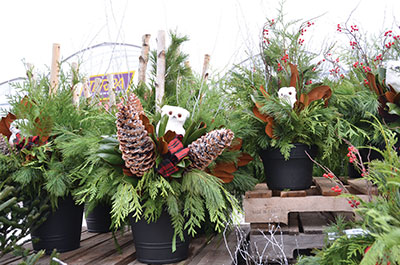 |
|
| Greenery is increasingly popular with consumers. Advertisement
|
Here are some guidelines and observations that could help with finishing your poinsettia crop.
With varieties that are already over-programmed for an earlier finishing date, finish the crops cool.
However, with some late-flowering varieties, by finishing cool we might miss the shipping date or Christmas completely – especially in low-light regions or low-light areas of the greenhouse.
Finishing cool night temperatures are not meant to be lower than 17 C night temperatures with low humidity. Heating and venting are needed if the outside temperature is moderate.
CHECK THE ROOTS
A note of caution: cool, wet roots are a recipe for pythium disease, and no, a fungicide drench is not the answer.
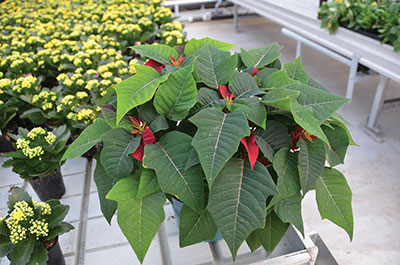 |
|
| Oops – a Bonzi overdose. Be careful with growth regulators.
|
As you know, the red, white, pink and other colours are the bracts that develop after bud-set. However, for proper bract colouring, the plants need all the light they can get during the day.
High night temperatures above 25-26 C will delay bud-set and keep plants vegetative. Be aware of hot spots in your greenhouse, especially around heat traps – flower delay with high temperatures is magnified with low light.
Check the EC of your media. A balanced fertility program is needed. Be aware that plants need a minimal amount of phosphorous through to the end of the crop. A minimum of 10 ppm P2O5 is a must, or bottom leaves will turn yellow, will not develop or will drop. A complete soil analysis is required every two weeks. An early shift to a fertilizer formulation that contains no phosphorous will lead to a very inferior crop up to the point of being unsaleable.
Use higher nitrate nitrogen instead of ammonium nitrogen-based source fertilizers. With low light and cool temperatures, having a large percentage of the nitrogen as ammonium-based fertilizer could be toxic to poinsettias.
Micro drenches of Bonzi proved to be effective with excellent quality poinsettias. Micro drenches are from 0.04 ppm to 0.08. Do not apply on the foliage or the forming bracts, because bract size will diminish drastically and flowering delay could result.
The proper shipping temperature for poinsettia is 12-13 C.
PLANNING FOR 2015
We grow poinsettias once a year, and from one crop to the next, there is enough time for our memory to fail us on what we want to change and the improvements we want to apply to the next crop.
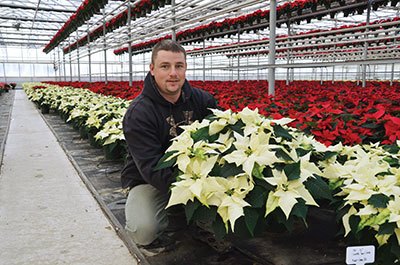 |
|
| Paul Stigter of Warren Greenhouses in Kitchener, Ontario, with a good example of ‘Winter Sun’ last season. |
If we grow a good crop, we like to do it again, but if our crop was poor, we want to make changes. In either case, the change to – or repetition of – our growing program requires concrete information from the previous season’s crop.
If you already keep records, that is great. But don’t stop there. Make sure you add another column or crop sheet to record what you would like to see happen next year.
If you don’t have records, it is still possible to recall or gather the scattered information to give you a starting point to begin record-keeping so you can document next year’s plan. If the information is not complete, that is still okay. The important thing is to have a plan for next year’s crop and to get into the habit of planning the next crop.
The technology for growing poinsettia is very diverse and the information sources are many. However, as good as the information sources are, they only reflect specific environmental conditions and practices that normally are not detailed enough with the emphasis on one aspect of growing the plants.
These details would include variety choice, chemicals, fertilizers, temperature deliverance, watering method, growth regulator treatment (chemically or culturally), number of cuttings per pot, different varieties with different pot sizes, various packaging (rings, sleeves, pot covers), shipping temperatures, and length of time the product was in boxes before reaching the customer.
GO SLOW WITH NEW IDEAS
Needless to say, incorporating one new idea recommended by somebody can be both beneficial and detrimental at the same time.
- Beneficial, because that is how we improve our culture, but only if we apply the new information on a small scale and wait until the next crop to fully adopt the new culture or product.
- Dangerous, because of not knowing all the variables associated with the change and your crop conditions.
- Since growing poinsettia, or any other crop, is a totally integrated process, changing one aspect normally means adjusting some of the methods and applications that we currently use to grow our crop.
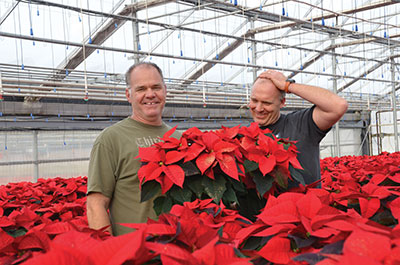 |
|
| Pete and Paul Vos of Vos Greenhouses in Freelton, Ontario, celebrated another successful crop of ‘Christmas Day’ last year.
|
Here are some guidelines on crop (or more specifically poinsettia) record-keeping and explanations.
Create a form/spreadsheet as a template that you will use to record your data. Included here is an example spreadsheet you can print. It can also be found on the Greenhouse Canada website (enter “crop cookbook” in the search link).
Start with the timing of rooting your poinsettias and the media used, condition of cuttings, temperature rooted at, days it took to root, and condition or quality of the rooted cuttings upon planting. These all have an impact on the finished product, timing and quality.
Rooting of cuttings: If you are rooting your own cuttings, then a cookbook is needed just to cover rooting cuttings and should include:
- Temperatures, day and night from Day 1 (sticking day) until finish.
- Misting cycles and duration – Day 1 to finish.
- Any treatments (growth regulators, fungicides, etc.).
- Fertilizer programs.
- Listing any abnormal conditions according to your practices.
- Any one program does not apply to all varieties – making adjustments to the program to accommodate the varieties is a must!
- Record of planting, pinching, spacing lights/blackout start and stop are very important in crop development – from root development to finish.
Even the date of the crop going from hand-watering to trough, floor or drip irrigation is important. This is because the breaks in development after pinching and type or irrigation will affect the root development.
 |
|
| A new variety that hopefully will never reach the market! | |
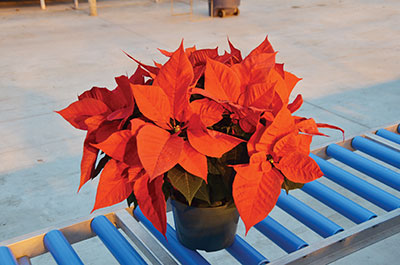 |
|
| Applying Fascination helped this grower overcome earlier problems associated with too much Bonzi. |
Growing media: Document media that drains well and has good aeration because poinsettia roots need lots of oxygen for proper growth – especially during the dark fall weather.
Keeping records of the soil mixes is a must. Remember that some soil mixes have one trade name but come in different analysis specs. You need to know your media composition by percentages and know the nutrient charge and lime types and ratio to each other.
Water: It’s important to record your water analysis, type of irrigation, and whether you’re a wet or dry grower. If you forgot to water the crop once with the result it was dried out for 24 hours or more, this will affect the crop through to the end. If hand-watering, note if a different person is watering the crop.
Temperature: List the average temperature set and what actually happened. You can speed up or delay a crop by up to two weeks just by temperature adjustment.
Growth regulators: Growth regulator applications and height measurements require that you make sure you record the rate, the volume used and at what stage, and the environmental conditions.
IPM: Record all treatments – biological or chemical – and at what growth stage the plants are at. Also, record any signs of phytotoxicity and effectiveness.
‘PLANT READY’ versus ‘SALE TARGET READY’
Hopefully, when you planted the crop, you had in mind a target sale date, which is great if it is the same date the plants are ready for sale! However, if it is not, a record of plant-ready dates will allow you to make the necessary adjustments to have the plant-ready date right on the sale-target date.
VARIETY SELECTION
There are over 150 varieties on the market, which could be good in giving us a lot of choice, or bad because we don’t have time to try them all to know what to choose! At the end of the crop, you know very well the varieties that performed well and those that didn’t.
After analyzing the reasons why some varieties didn’t work, and you know it was an inferior variety and not because you didn’t do something right, then it is time to drop that variety and pick one from those you are trialling. About two to three per cent of your crop should be devoted to trialling new varieties so you can improve on variety selection.
TECHNOLOGY
With all the modern technology of computers, digital cameras, scanners, etc., it is very important to take advantage of them by having computerized cookbooks that can include geographical tracking, soil tests, and all other information including digital photos of the crop development – with dates – so you can refer to it next season.
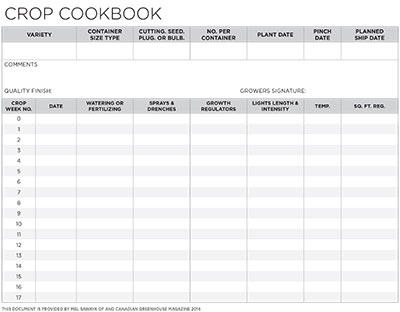 |
|
| A page from the Crop Cookbook. There is a link on the Greenhouse Canada website to download the file.
|
Planning is the basis for any successful venture in greenhouses or field farming, or indeed for any job and life in general. The basis for successful planning is to be timely and targeted.
It is like a pilot flying a plane – they always have a destination target and a path they have planned to take. However, they must constantly make flight corrections because outside factors, such as winds, cloud cover, etc., will take the plane off the desired path. It is important to keep your destination in mind and make corrections as you go.
Always be prepared to look for something new to learn. Ask questions about the things you are not familiar with. Listen to others (colleagues, seminars, any other information source) then Act – on a trial basis – on the information and then enlarge your usage if it is an improvement.
By practising this sequence, you would put a different meaning to being in “LALA Land” because you will be a successful person and the envy of others.
Melhem Sawaya of Focus Greenhouse Management is a consultant and research coordinator to the horticultural industry. Comments on this or any other article are always welcome at mel@focusgreenhousemanagement.com, or visit www.focusgreenhousemanagement.com or www.sawayagardentrials.ca.
Print this page